
John Mitchel was an Protestant Irish nationalist activist, author, and political journalist. In the Famine years of the 1840s he was a leading writer for The Nation newspaper produced by the Young Ireland group and their splinter from Daniel O'Connell's Repeal Association, the Irish Confederation. As editor of his own paper, the United Irishman, in 1848 Mitchel was sentenced to 14-years penal transportation, the penalty for his advocacy of James Fintan Lalor's programme of co-ordinated resistance to exactions of landlords and to the continued shipment of harvests to England.

The Nation was an Irish nationalist weekly newspaper, published in the 19th century. The Nation was printed first at 12 Trinity Street, Dublin from 15 October 1842 until 6 January 1844. The paper was afterwards published at 4 D'Olier Street from 13 July 1844, to 28 July 1848, when the issue for the following day was seized and the paper suppressed. It was published again in Middle Abbey Street on its revival in September 1849.

Sir Charles Gavan Duffy, KCMG, PC, was an Irish poet and journalist, Young Irelander and tenant-rights activist. After emigrating to Australia in 1856 he entered the politics of Victoria on a platform of land reform, and in 1871–1872 served as the colony's 8th Premier.

William Smith O'Brien was an Irish nationalist Member of Parliament (MP) and a leader of the Young Ireland movement. He also encouraged the use of the Irish language. He was convicted of sedition for his part in the Young Irelander "Famine Rebellion" of 1848 but his sentence of death was commuted to deportation to Van Diemen's Land. In 1854, he was released on the condition of exile from Ireland, and he lived in Brussels for two years. In 1856 Smith O'Brien was pardoned and returned to Ireland, but he was never active again in politics.

John Blake Dillon was an Irish writer and politician who was one of the founding members of the Young Ireland movement.

Terence Bellew MacManus was an Irish rebel who participated in the Young Irelander Rebellion of 1848. Sentenced to death for treason, he and several other participants were given commuted sentences in 1849 and transported for life to Van Diemen's Land in Australia. Three years later in 1852, MacManus escaped and emigrated to the United States.

Thomas Francis Meagher was an Irish nationalist and leader of the Young Irelanders in the Rebellion of 1848. After being convicted of sedition, he was first sentenced to death, but received transportation for life to Van Diemen's Land in Australia.

Young Ireland was a political and cultural movement in the 1840s committed to an all-Ireland struggle for independence and democratic reform. Grouped around the Dublin weekly The Nation, it took issue with the compromises and clericalism of the larger national movement, Daniel O'Connell's Repeal Association, from which it seceded in 1847. Despairing, in the face of the Great Famine, of any other course, in 1848 Young Irelanders attempted an insurrection. Following the arrest and the exile of most of their leading figures, the movement split between those who carried the commitment to "physical force" forward into the Irish Republican Brotherhood, and those who sought to build a "League of North and South" linking an independent Irish parliamentary party to tenant agitation for land reform.

Dr. Robert Cane (1807–1858), was born in Kilkenny, Ireland in 1807. He was a member of the Repeal Association and the Irish Confederation. He qualified as an M.D. in 1836, became a member of Kilkenny Corporation and was Mayor twice.

The Young Irelander Rebellion was a failed Irish nationalist uprising led by the Young Ireland movement, part of the wider Revolutions of 1848 that affected most of Europe. It took place on 29 July 1848 at Farranrory, a small settlement about 4.3 km north-northeast of the village of Ballingarry, South Tipperary. After being chased by a force of Young Irelanders and their supporters, an Irish Constabulary unit took refuge in a house and held those inside as hostages. A several-hour gunfight followed, but the rebels fled after a large group of police reinforcements arrived.
John Edward Pigot (1822–1871) was an Irish music collector and lawyer, who played a key role in the foundation of the National Gallery of Ireland.

Patrick O'Donoghue (1810–1854), also known as Patrick O'Donohoe or O'Donoghoe, from Clonegal, County Carlow, was an Irish Nationalist revolutionary and journalist, a member of the Young Ireland movement.
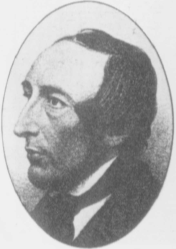
John Martin was an Irish nationalist activist who shifted from early militant support for Young Ireland and Repeal, to non-violent alternatives such as support for tenant farmers' rights and eventually as the first Home Rule MP, for Meath 1871–1875.
The Irish Confederation was an Irish nationalist independence movement, established on 13 January 1847 by members of the Young Ireland movement who had seceded from Daniel O'Connell's Repeal Association. Historian T. W. Moody described it as "the official organisation of Young Ireland".

Thomas Devin Reilly(Tomás Damhán Ó Raghailligh) was an Irish revolutionary, Young Irelander and journalist.
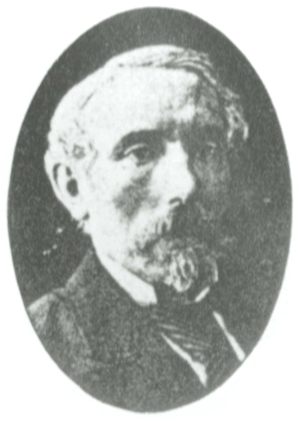
Patrick James Smyth, also known as Nicaragua Smyth, was an Irish politician and journalist. A Young Irelander in 1848, and subsequently a journalist in American exile, from 1871 he was an Irish Home Rule Member of the United Kingdom Parliament for Westmeath and from 1880 for Tipperary.
Thomas MacNevin was an influential Irish writer and journalist, who died under "peculiarly sad circumstances" in a Bristol asylum. According to T. F. O'Sullivan, he was one of the most "brilliant intellects" to be associated with The Nation newspaper and with the Young Ireland movement.
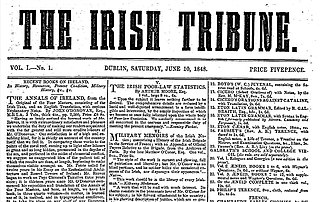
The Irish Tribune was a short-lived nationalist newspaper printed weekly in Dublin in 1848. Five issues were published until its suppression by the British Government.
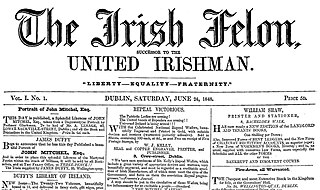
The Irish Felon was a nationalist weekly journal printed in Dublin in 1848. Only five issues were published before its suppression by the British Government.
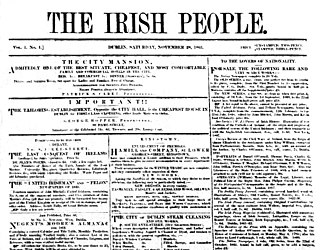
The Irish People was a nationalist weekly newspaper first printed in Dublin in 1863 and supportive of the Fenian movement. It was suppressed by the British Government in 1865.


















